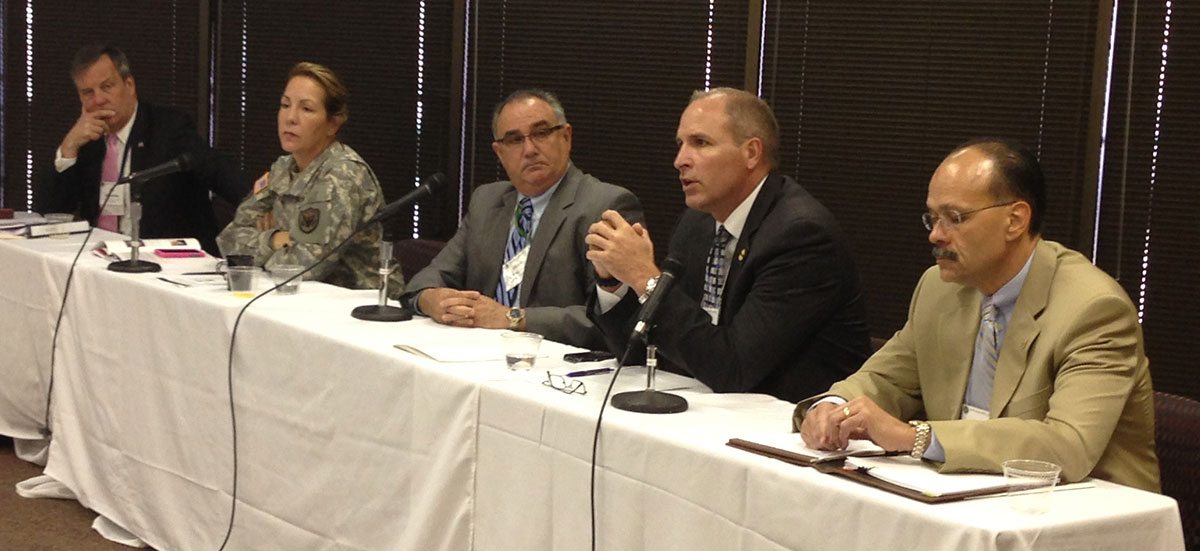
DEA Special Agent in Charge Joseph Arabit (far right) said that violence in Juárez was down about 74 percent from its peak in 2010. (Anoushka Valodya/Borderzine.com)
EL PASO – The word “partnership” was frequently used at the round table discussion of “Security Along the U.S.-Mexico Border” to explain what it takes to counter terrorism.
This event was one of the many sessions of the 9th annual International Association For Intelligence Education (IAFIE) conference at the University of Texas at El Paso Wednesday.
Five government officials of various agencies, such as the Drug Enforcement Administration and the Federal Bureau of Investigation (FBI) spoke in the panel.
UTEP’s Vice-Provost Michael Smith began the session as the moderator.
“This is a topic of keen interest obviously in El Paso and along the border region,” Smith said.
One government official mentioned a few obstacles to securing the U.S.-Mexico border.
“Our major focus is to target the major traffic organizations – the Sinaloa and Juárez cartels. Among the many challenges is the cross-border traffic,” Joseph Arabit, special agent in charge at the Drug Enforcement Administration in El Paso, said. “Last year there were about six million pedestrians that crossed the bridges in our area, and about 10 million vehicles, both commercial and personal. So that presents a huge, huge challenge for us. Another challenge is the warehouses on both sides of the border. And last, but certainly not least, the border violence has been a challenge for us in the last six or so years.”
Arabit said that there’s something to be glad about in our area.
“I got to tell you. It’s encouraging to say that violence [in Juárez] is down about 74 percent from its peak in 2010,” Arabit said. “In that year, Juárez had 3,600 murders. To date, there are about 180 murders, and while 180 is still a lot – it’s not in the thousands – it’s in the hundreds.”
Arabit also praised the benefits of partnering up with other organizations.

This year’s IAFIE conference hosted 33 panels over a four-day period since Monday at UTEP’s Union building. (Anoushka Valodya/Borderzine.com)
“We do nothing in this region alone. We do it with collaboration of our federal, state, and local partners,” Arabit said. “Every agency has a different resource, different authority, different experience to bring to the fight, if you will. Our intelligence sharing mechanism is robust, and the bottom line is our number one priority in keeping the community safe, ensuring that the horrific violence that has occurred over the past several years in Juárez does not spill over.”
Army Col. Marisa Tanner, intelligence director for Joint Task Force North at Fort Bliss, said that the 19,000 miles of the U.S.-Mexico border is just a fraction of the scope of the drug war.
“We have a growing, emerging threat. Sometimes our population within our nation sees it as a Mexico problem. It isn’t,” Tanner said. “If you look at drugs and terrorism, it is no longer confined to the Southwest border. It is a globalization. The drug war, in terms of drug cartels, is a very fine-tuned illicit enterprise.”
Tanner added that working with other organizations is key.
“I’m part of a task force whose mission is to integrate our DoD [Department of Defense] capabilities with our law enforcement partners to counter drug and counter the terrorism nexus. It’s truly a partnership,” Tanner said. “We are often separated by authorities and sometimes budgets, but we really do come together at a level right at the frontline. At the end of the day, whether it’s drugs or terrorism, it’s border security.”
One of the audience members was a UTEP student who paid $100 to attend this event.
Carlos Serna, a sophomore majoring in linguistics and minoring in intelligence and national security studies, said that he came to “explore what I want to do as far as my career.”
He said that he wants to go into law enforcement but isn’t sure what area to work in. This conference session hopefully shed light on some career paths, he said.
“I want to learn more about being an analyst, what an analyst job is all about, to see if I want to do that,” he said.
This year’s IAFIE conference hosted 33 panels over a four-day period since Monday at UTEP’s Union building.
According to the IAFIE website, “the mission of the Association is to advance research, knowledge, and professional development in intelligence education.” Other topics of this conference included “Intelligence Community Centers for Academic Excellence” and “The Threat of Domestic Biological Terrorism: Fact or Fiction?”


